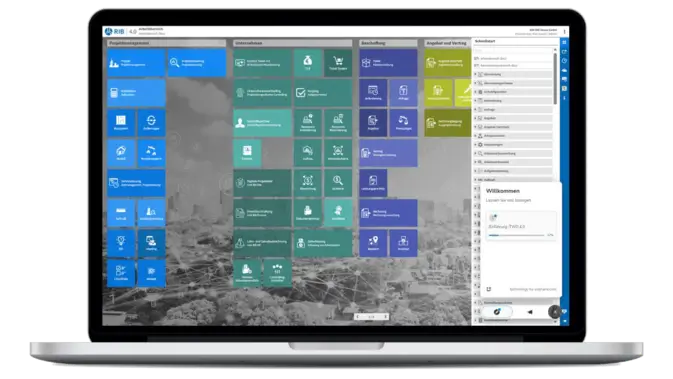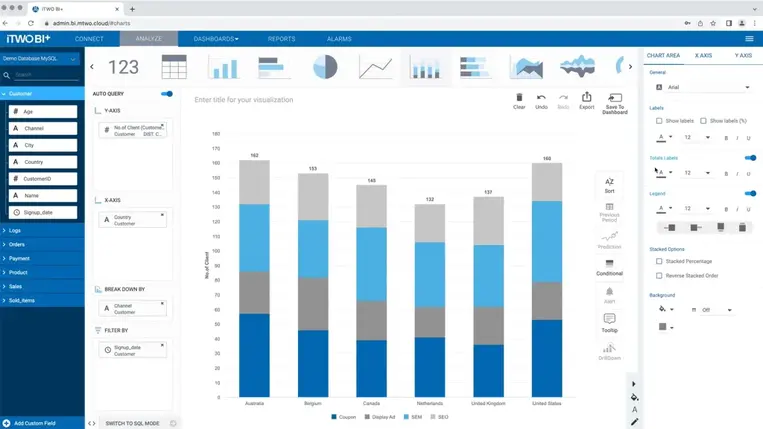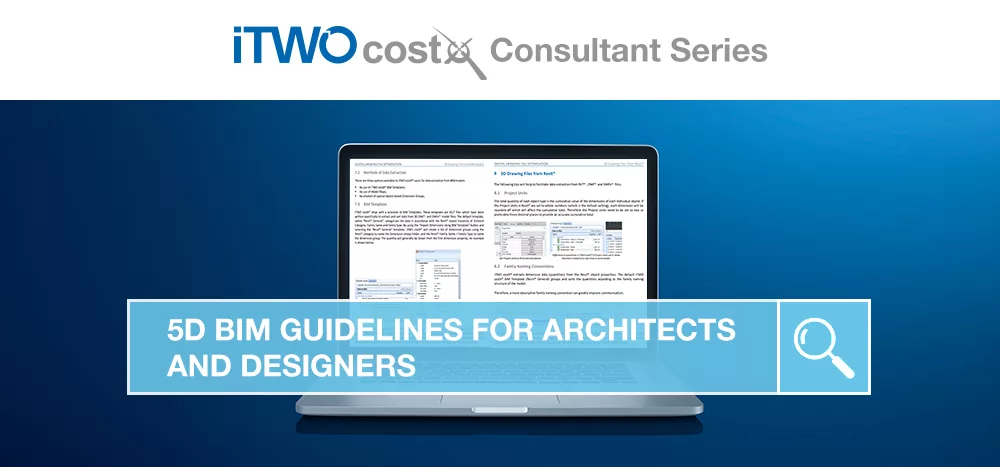24 mins read
Understanding Cloud-Based Solutions For The Construction Industry

Today, we can access masses of highly sensitive information quickly and easily via mobile devices and any other form of web-enabled platform. However, the construction world has customarily dragged its feet in keeping pace, especially where third-party contractors are involved. Some still rely heavily on paper-based procedures, which are inherently slow, promote bottlenecks, and create cost implications. But all that is changing: cloud-based solutions have begun to make waves in the industry as more and more construction companies realize that a cloud environment can become their most significant competitive advantage.
So, how is construction cloud software shaping the future of the built environment? Keep reading to find out!
Why Should Construction Businesses Move To The Cloud?
If we can open a mobile phone app and look at our bank account information in real-time, is there any reason a construction business shouldn’t be able to look at information relating to an ongoing project in the same way? By making these elements available through the cloud, essential data and information become accessible in real-time without the need to be tethered to a desk or fixed server. But this wasn’t always the case.
Decades ago, before computers and smartphones existed, construction companies had to record every task or process related to a project on paper. Then came computers and the Internet, and those papers mutated into digital documents. However, this still presented an issue, as employees needed to go from the site to the office to update these documents, which could result in a loss of information, not to mention how hard it was to collaborate with others.
It was not until 2007, with the rise of smartphones (and tablets later in 2010), that the industry realized the power of digital construction technologies. A little after that, cloud solutions revolutionized industries in all areas. Construction companies realized the value of working remotely and using technologies to do so. This became even more of a reality after the pandemic forced businesses to dive into digital transformation, making cloud software the norm for most tech-driven organizations today.
From a purely financial perspective, cloud-based construction management software can deliver tangible savings. Those savings can be derived from initial and replacement (upgraded) hardware and server requirements, reduced fixed office space requirements, and the financial benefit derived from instant information access from anywhere at any time.
Much like the ease with which even young children can add apps and functions to their mobile devices, that same easy access and integration is possible with cloud-based construction software and applications. The knock-on benefit can be felt in having the confidence to bid for additional projects safe in the knowledge the business will be able to scale up to meet the demand instantly, removing potential barriers to business that revolve around authorizing additional equipment and expenditure where time is of the essence.
If you are still unsure about the value of cloud technology for your construction business, keep reading to learn about some tangible benefits of these tools.
Benefits Of Construction Cloud Software
Unless you are an IT wizard or programmer, the actual workings inside cloud applications (the engines themselves) will be of little interest to you. Many people asking this question want to know what the solution will offer in real terms to the users and the organizations that apply it. So, let’s dive a little deeper into what the platforms offer!

1. Virtual Linking of Construction Sites
Traditionally, status updates required visiting the people on the ground to see the progress being made for yourself. By utilizing your cloud functions effectively, progress can be updated in real-time by the staff on sites across all locations, giving accurate and up-to-date information. This makes the project more efficient, less error-prone, and more cost-effective.
2. Centralized construction project management
Nothing makes more sense than having a single source of truth throughout your project. Disparate systems and applications lead to a disconnect between teams, which increases costs, time to completion, and, in the worst case, on-site errors that can put the safety of workers at risk. Construction cloud software provides a centralized location that merges all your data and systems in one place. This means that strategic and operational decisions are easier to make on the go. Also, if every piece of information related to the project is in a centralized location, it is easier to search for critical data, avoiding time wasting searching through an infinite list of documents and systems.
Construction collaboration is critical to a project’s success. Another benefit of the centralized cloud environment is a significant boost in collaboration. The software tracks any changes made so any team member or authorized stakeholders can access the latest information available and adapt their workflow accordingly. Plus, this level of collaboration saves time in unnecessary meetings; if someone needs access to information, they need to look for it instead of waiting for people from other areas to answer and provide it to them.
4. Increased capacity for data processing
Extracting the most meaningful insights from a construction project demands that vast amounts of data be processed and interpreted. A powerful example relates to capturing imagery from a drone inspection, where the drone captures thousands of images and data (GPS coordinates and measurements) every second. This information is then fed into advanced software that cannot function on a standard piece of computer hardware but can be sent directly to your cloud infrastructure, where the capacity for processing and storage is (to all intents and purposes) unlimited. Multiply that benefit across all functions and on-site data inputs, and the benefits become exponential.
5. Protecting and sharing your data
Regulations, best practices, and commonsense dictate that documenting every aspect of a project along the way is essential. When this data is captured locally to be downloaded and stored physically later, there is a very significant risk of data loss or corruption. This risk is eradicated by uploading this data onsite straight into the cloud, making the data instantly available to all stakeholders.
6. Enabling meaningful analytics
The development and evolution of construction cloud solutions can occasionally require users to expand and evolve their thinking and practices. By removing the restrictions of data handling, huge files can be accessed and evaluated from remote locations. The capacity of the software and applications in the cloud does not restrict the processing power of the device used.
As with many aspects of the cloud for construction, there is no requirement to physically relocate to the base to run analytics and comparisons, as all the data and processing power are available in real-time from anywhere in the world (provided you are authorized to access it, of course).
Expanding on the previous point, the level of accessibility provided by the cloud makes things that were unimaginable in the future a reality. Cross-device accessibility is one of them. As we’ve already mentioned, a few years back, construction employees had to be at the office to update desktop-based documents and make analyses. Today, construction reports, drawings, 3D models, and more can all be accessed online from any smart device. This allows for onsite decision-making, mitigating the consequences of unexpected issues or mistakes. Plus, all the data can be easily shared, and changes can be viewed as soon as they are made, making collaboration way more efficient.
Common Myths Of Construction Cloud Solutions
Considering the cons is an important aspect of making an informed decision. However, potential cons are frequently based on misunderstanding or, dare I say it, slightly outdated thinking related to data solutions and data handling. Let’s explore some FAQ’s about using cloud-based software in the construction industry.
This common misconception is primarily related to the perception of giving up physical control of your data. Your data is more secure in a cloud environment. You have already eliminated the potential for physical loss or damage to data by not storing it on local devices, and the level of security in cloud storage is unprecedented. Due to the sensitive nature of cloud data, the levels of security are in the realms of Fort Knox. Economies of scale allow cloud server providers to apply the best and cutting-edge security systems that individual users would likely balk at trying to pay for and provide for themselves.
2. Do cloud servers ever go “down”?
It would be impossible to say that any server will never drop out or go down. The focus should be on measures to cater for such events. As with security systems, cloud data servers have a similar ability to provide redundancy measures and cover for potential server downtime, which renders this fear moot. Even during its infancy, server outages were extremely rare, and for such short timeframes, the benefits dwarfed the potential inconvenience a limited downtime might present.
Cloud solutions are not cheap, but when will anything of significant value be? That said, on a like-for-like basis, they are often less costly than physical server solutions, particularly when you factor in the cost of new and replacement hardware and servicing.
Plus, the ROI of cloud-based construction project management is potentially enormous. In challenging times and a very competitive market, however, it is important to acknowledge that solutions need to be tailored to suit the needs and capabilities of individual businesses, and cloud solutions provide an extra option that has long been required.
We are talking about the ability to scale up and down as required, both in terms of user access and the ever-changing demands in the fluid world of project management in construction. This scaling is made largely available due to the ease of setting up cloud access in deference to embedding and installing specific hardware.
4. Do I need 24/7 internet access?
This was a far more significant problem in the past when internet access was patchier. However, there will be ‘dead areas,’ particularly if operating in remote locations. Software providers have ensured this is catered for by reverting to an offline capability to kick in where required. This is further supported by transferring any temporarily held data after the internet link is re-established.
Top Cloud-Based Construction Software Examples
A construction project involves many stages and processes, and over the years, a wide range of cloud solutions have been developed to assist in each stage. Below, we will discuss some common software categories in the industry.
1. Cloud-based Construction Management Software
As its name suggests, this type of construction cloud software offers unified access to every aspect of a project, making collaboration way easier while boosting efficiency and productivity. Some solutions in this category might only offer the client or contractor internal access. Others offer accessibility and collaboration between every single stakeholder, making the entire process more time-consuming. In today’s fast-paced world, construction companies cannot afford to work in a decentralized environment, and management solutions eliminate this issue.
RIB Connex

RIB Connex is a construction project management software that helps teams break down communication silos by offering every stakeholder the opportunity to access and share key insights in a unique location. With the help of modern dashboard technology, users can track all changes and new developments in the project to mitigate risks and increase construction productivity. The tool also allows users to generate configurable workflows and processes to meet the project and company’s specific needs, representing a big competitive advantage.
Key features:
- ▷ Interactive BIM viewer with easy access to 2D drawings and 3D models
- ▷ Real-time field management with the ability to record any changes from a mobile device
- ▷ Digital quality management to monitor all inspections and tackle any issues that arise
2. Cloud-based Construction Estimating & Planning Software
Cloud-based planning solutions allow construction companies to optimize the entire project lifecycle from the first stage. These specialized tools help streamline and automate multiple tasks, ensuring efficiency, precision, and collaboration. Platforms like this also help during the estimating process, making it way more efficient and less error-prone, ensuring projects are delivered on time and within the expected budget.
RIB Candy Cloud

RIB Candy Cloud is cloud-based software that aids businesses in several processes, including on-screen quantity takeoff, estimating, and planning and control. The software offers a centralized location to monitor and manage crucial data to ensure every aspect of the project runs as expected. This level of accessibility helps eliminate departmental silos while ensuring accountability and transparency regarding data usage. Additionally, the tool allows for comprehensive analysis to boost tendering, resource allocation, and overall planning, helping ensure everything remains time and cost-efficient.
Key features:
- ▷ First Principles Resource-Based Estimating to improve speed, accuracy, and transparency of estimates
- ▷ Forecasting module to efficiently predict quantities, values, and resources
- ▷ Financial modeling and scenario planning to enhance cost and revenue management
3. Cloud-based Construction Enterprise Platform (ERP)
A cloud ERP is designed to help small and large construction companies manage all business processes in a single platform. It saves organizations money and time by automating several tasks, including project management, budgeting, payroll, scheduling, and much more. Plus, cloud-based ERP systems allow team members and other stakeholders to track progress or changes in real-time regardless of location, making the entire project workflow more efficient. Even better, most ERPs out there are scalable, which means they adapt as your company grows, making them more cost-effective as well.
RIB 4.0

RIB 4.0 is cloud ERP that seamlessly integrates all project stages, from planning to construction to operations, for enhanced collaboration, productivity, and ROI. Powered by 6D BIM technology, decision-makers can link people, processes, and data to streamline enterprise-wide workflows and work in real time with updated information. Paired with that, RIB 4.0 allows enterprises to unify all projects to compare the data and extract valuable conclusions to boost productivity.
Key features:
- ▷ Track all contracts and evaluate the performance of different business partners
- ▷ A centralized document library that gives users the power to access and share crucial forms and records
- ▷ Preplan and schedule resource allocation of employees, materials, and equipment efficiently
4. Cloud-based Construction Business Intelligence Software
Construction is one of the biggest industries in the world. As such, it produces massive amounts of data every day. This data needs to be carefully stored and analyzed to enable its use as a competitive advantage. Cloud BI software does just that. It provides construction companies with a centralized, online environment to gather, monitor, and analyze all project data efficiently and in a visually appealing format. Through that, decision-makers can access the performance of their most relevant KPIs and track it in real-time to make critical strategic decisions related to resource allocation, costs, and more.
RIB BI+

RIB BI+ is powerful business intelligence software that allows construction companies to connect all their data sources seamlessly in a single platform. The data can be visualized in interactive dashboards containing different graphs and charts, enabling users to navigate and explore the data to answer critical questions. The best part is the tool has an intuitive interface that makes it easy for all project members, regardless of their technical background, to use data to their advantage and perform self-service analytics. Plus, the online environment of BI+ sets the grounds for enhanced collaboration and communication between all stakeholders, as dashboards and reports can be easily shared and accessed from various devices.
Key features:
- ▷ Intelligent data alarms that notify users about any unexpected changes or goal completion, avoiding having to check the dashboard all the time manually
- ▷ The Connect Overview works as a central point of access for all data sources, enabling real-time updates and cross-database analysis
- ▷ KPI and dashboard templates to accelerate the analysis process and make it more visually appealing
5. Cloud-based Construction Takeoff, Estimating & Reporting Solution
Traditionally, construction estimating and takeoff were performed manually using spreadsheets. While this might have worked in the past, the process is highly subject to manual error, not to mention how time-consuming it is. Luckily, cloud-based tools eliminate the pains of manual takeoff by offering automated counts from digital drawings. This not only increases the accuracy of estimations but also shortens the process from days to just a couple of hours. Plus, estimators can stop at any time with the confidence that their progress is saved and will be there when they return. This also allows for later comparisons to understand how accurate your estimations were.
RIB CostX

RIB CostX is an all-in-one takeoff, estimating, and reporting platform that eliminates the common pains of these processes with error-free results. The platform allows quantity takeoff on various commonly encountered design document formats and has multiple deployment options, making it highly accessible and easy to use. Plus, it adapts to the requirements of different projects, regions, roles, and industries for increased transparency and accuracy.
Key features:
- ▷ 2D takeoff allows teams to measure counts, lengths, and areas with a single click
- ▷ 6D BIM technology to estimate embodied carbon, assess project implications, and implement sustainability strategies
- ▷ Revision tracking to see how design changes affect overall costs and environmental impact
6. Cloud-based Construction Specification Platform
Writing construction specifications can be tedious if the process is not supported by the right tools. Cloud construction specification software helps standardize the process by offering an automated, online environment for specifications, making it more accurate, compliant, and time efficient. Plus, it reduces the risk of human error as everything is processed by the software, which provides more visibility and accuracy.
RIB SpecLink

RIB SpecLink is a cloud-based, centralized specification solution that generates accurate and dynamic specifications using automation technology and CSI-standard content. The cloud’s online environment allows team members to contribute to the spec writing process while giving spec experts the control and visibility they need to complete the final output. This makes the process more collaborative and efficient as any conflicts or considerations are highlighted and can be considered to drive better outcomes.
Key features:
- ▷ Mobile and web-based access to view, share, edit, and comment specs on the go
- ▷ Up-to-date database of 910+ content sections, 3000 + reference standards, sustainable design provisions, and more.
- ▷ Full integration with Revit BIM software to connect specs with 3D models and adapt them in real-time
How To Choose The Best Cloud Construction Software
By now, you should be more familiar with the benefits of cloud-based software for the construction industry. If you are ready to invest in one for your company, we advise you to follow the best practices and considerations below.
Think about your needs and objectives
As mentioned earlier in the post, these tools can be more expensive because of the advanced functionalities and technologies they provide. This can change from provider to provider; therefore, we recommend always considering your needs and objectives before investing in any tool. What works for others might not work for your business, so putting your specific requirements first is the best course of action.
Consider customization capabilities
Every project and company is different and requires different things. As such, the software you invest in should allow you to customize the different features to meet your specific needs. For example, having the ability to generate customized templates to keep everyone on the same page is a must.
Some construction cloud software providers allow companies to only pay for the features they need instead of a complete, overpriced package with unnecessary features. This level of customization also makes for a smarter, more cost-effective investment.
Insist on strong integration capabilities
As mentioned repeatedly throughout this post, collaboration is key in construction, and boosting it is one of the significant benefits of the cloud. Considering that, the software you choose should have accessibility and integration capabilities at its core. You want the platform you invest in to help you connect all your systems, data, and teams in a single location to boost productivity and transparency across the entire project lifecycle. Strong integration will ensure better communication and fewer errors, translating into better cost management.
Documentation and support are a must
It might sound like a given, but many software providers fail regarding documentation and support. No matter how many years of experience in the industry you have, using new technology has a learning curve, and having the proper support is of utmost importance to make the most out of your investment. Therefore, look for a tool that offers quality online and offline support for all team members.
Security and privacy should be a priority
Security and privacy should be a top priority when looking for the best cloud software for the construction industry. Construction companies manage massive amounts, accessed by multiple people daily; a breach of that information could have severe consequences for the company. Therefore, ensuring a secure environment is a must. For instance, some construction software solutions offer role management features to ensure only the right people can access the data. The roles also dictate what information each user can access and whether they can edit, manipulate, or export it.
Final Thoughts
This article aimed to answer some of the frequently asked questions about cloud-based software for the construction industry. You can explore the specific benefits for your business by speaking to some of the frontrunners who have dealt firsthand with implementing and operating these systems.
Speaking to professionals who fully understand and can articulate the features and benefits and how they can be applied to your business can help you make an informed decision. Contact RIB, a leading specialist construction software developer, and leverage our expertise to discover how cloud solutions can enhance your operations now and as they develop further into the future. You can also explore our product toolkit and book a demo to experience the power of the cloud for yourself!
Most Recent
24 mins read
14 mins read
15 mins read
15 mins read

E-BOOK











